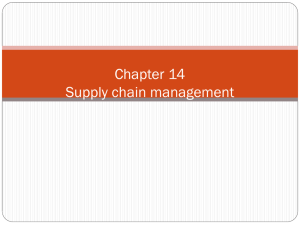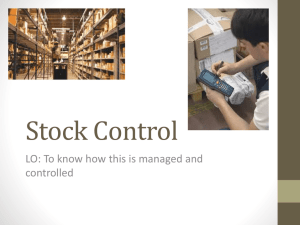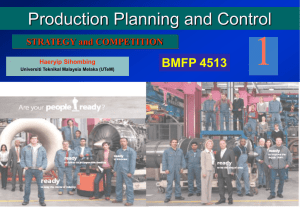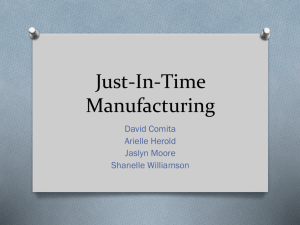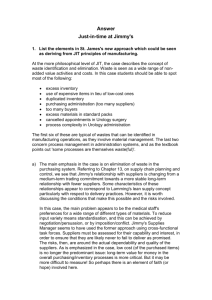Proceedings of 29th International Business Research Conference
advertisement
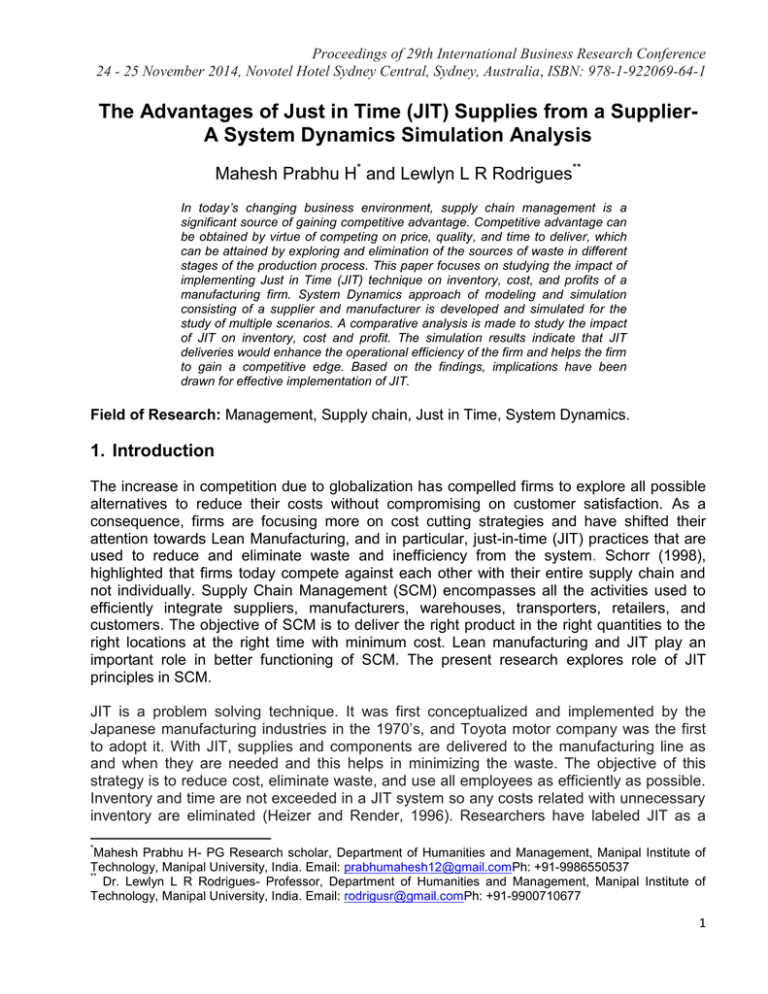
Proceedings of 29th International Business Research Conference 24 - 25 November 2014, Novotel Hotel Sydney Central, Sydney, Australia, ISBN: 978-1-922069-64-1 The Advantages of Just in Time (JIT) Supplies from a SupplierA System Dynamics Simulation Analysis Mahesh Prabhu H* and Lewlyn L R Rodrigues** In today’s changing business environment, supply chain management is a significant source of gaining competitive advantage. Competitive advantage can be obtained by virtue of competing on price, quality, and time to deliver, which can be attained by exploring and elimination of the sources of waste in different stages of the production process. This paper focuses on studying the impact of implementing Just in Time (JIT) technique on inventory, cost, and profits of a manufacturing firm. System Dynamics approach of modeling and simulation consisting of a supplier and manufacturer is developed and simulated for the study of multiple scenarios. A comparative analysis is made to study the impact of JIT on inventory, cost and profit. The simulation results indicate that JIT deliveries would enhance the operational efficiency of the firm and helps the firm to gain a competitive edge. Based on the findings, implications have been drawn for effective implementation of JIT. Field of Research: Management, Supply chain, Just in Time, System Dynamics. 1. Introduction The increase in competition due to globalization has compelled firms to explore all possible alternatives to reduce their costs without compromising on customer satisfaction. As a consequence, firms are focusing more on cost cutting strategies and have shifted their attention towards Lean Manufacturing, and in particular, just-in-time (JIT) practices that are used to reduce and eliminate waste and inefficiency from the system. Schorr (1998), highlighted that firms today compete against each other with their entire supply chain and not individually. Supply Chain Management (SCM) encompasses all the activities used to efficiently integrate suppliers, manufacturers, warehouses, transporters, retailers, and customers. The objective of SCM is to deliver the right product in the right quantities to the right locations at the right time with minimum cost. Lean manufacturing and JIT play an important role in better functioning of SCM. The present research explores role of JIT principles in SCM. JIT is a problem solving technique. It was first conceptualized and implemented by the Japanese manufacturing industries in the 1970‟s, and Toyota motor company was the first to adopt it. With JIT, supplies and components are delivered to the manufacturing line as and when they are needed and this helps in minimizing the waste. The objective of this strategy is to reduce cost, eliminate waste, and use all employees as efficiently as possible. Inventory and time are not exceeded in a JIT system so any costs related with unnecessary inventory are eliminated (Heizer and Render, 1996). Researchers have labeled JIT as a * Mahesh Prabhu H- PG Research scholar, Department of Humanities and Management, Manipal Institute of Technology, Manipal University, India. Email: prabhumahesh12@gmail.comPh: +91-9986550537 ** Dr. Lewlyn L R Rodrigues- Professor, Department of Humanities and Management, Manipal Institute of Technology, Manipal University, India. Email: rodrigusr@gmail.comPh: +91-9900710677 1 Proceedings of 29th International Business Research Conference 24 - 25 November 2014, Novotel Hotel Sydney Central, Sydney, Australia, ISBN: 978-1-922069-64-1 philosophy with the following objectives: making quality better and providing on time production, and shipment of products. 2. Problem Statement In a dyadic supply chain, where the inventories are continuously replenished by many suppliers, the quality of the product, timing of replenishment and the cost are of utmost importance to maintain competitive position in the market. These competitive priorities can be achieved by studying the supply chain activities and eliminating the sources of waste and Non-Value Adding activities. Therefore the problem statement of this research is to identify the sources of waste in supply chain and study the impact of its elimination on cost and profit. Lean manufacturing and JIT play an important role in better functioning of SCM. Some of the lean manufacturing principles are: JIT inventory principle and JIT production principle. The present research involves the role of JIT principles in SCM. In particular, the objective of this paper is to design a model of dyadic supply chain for a manufacturing system using a System Dynamics simulation modeling approach and to study the influence of JIT technique on inventory, cost and profit. 3. Literature Review The history and development of JIT:JIT is a manufacturing philosophy, which was first developed by the Japanese in the early 1970‟s. The Toyota manufacturing plant was the first to adopt the technique, under the leadership of Taiichi Ohno. Toyota realized that JIT would be successful only if all of the individuals within the plant were committed to accept the philosophy. The method was such a success that Taiichi Ohno was named father of JIT. The automotive industry is one of the largest that have been adopting the just in time method (Aghazadeh, 2004). Supply chain Management: A supply chain encompasses all activities associated with moving goods from raw material stage to end user. A supply chain consists of a variety of firms ranging from raw material suppliers to wholesalers and retailers. It also includes all types of organizations engaged in transportation, warehousing and materials handling. The essence of SCM philosophy is that waste reduction and enhanced supply chain performance come only when there is interfirm and intrafirm functional integration, sharing and cooperation (Brewer & Speh, 2000). Krisztina Demeter et al. (2011) studied how companies could improve their inventory turnover performance through the use of lean practices. They found a significant relationship between lean practices and inventory turnover. Upton (1998) has defined JIT as a managerial function or an operational philosophy whereas Narasimhan et al. (2006); Flynn et al.(1995) define JIT as techniques and practices that are used to implement and support lean philosophy. 2 Proceedings of 29th International Business Research Conference 24 - 25 November 2014, Novotel Hotel Sydney Central, Sydney, Australia, ISBN: 978-1-922069-64-1 The characteristics of JIT are outlined as set-up time reduction, supplying components in small quantities, adhering to the daily supply schedules, use of kanban cards etc. (Mackelprang & Nair, 2010; Motwani, 2003). Researchers began to highlight the importance of JIT in purchasing and inbound logistics once they started realizing the benefits of JIT in production process (Mistry, 2005; Kaynak, 2002).It is also pointed out that Vendor-kanban for raw materials and pull systems for logistics can be used to obtain JIT deliveries from supplier (Sakakibara et al.1993; Koh et al. 2007; Lamming, 1993). Further, it has been observed that under pull production system, the components are manufactured and shipped as per the demand and this can be accomplished by using kanban cards (Monden, 1981). The process of collecting small lots of ready to use components from suppliers located in a particular area at regular intervals of time as per the daily supply schedule and delivering it to the place of demand is called JIT delivery (Jones et al., 1997). The JIT production system‟ is defined by Sakakibara et al. (1997, p. 1247), as manufacturing “only the necessary products, at the necessary time, in the necessary quantity”. 4. Research Methodology 4.1 System Dynamics System Dynamics approach of modeling and simulation as proposed by Forrester (1994),is employed in the current research. The research steps in the proposed methodology as highlighted by Sushil (1993) include: Problem identification, System Conceptualization, Model formulation, Simulation & validation, and Policy analysis & improvement. Vensim®, the simulation software which is used in this research is developed by Ventana Systems, Inc. (Harvard, Massachusetts), and it is widely used software for SD modeling & simulation. Its purpose is to help companies to find an optimal solution for various situations that need analysis and where it is necessary to find out all possible results of future implementation or decision. Vensim® is able to simulate dynamic behavior of systems that are impossible to analyze without appropriate simulation software, as they are unpredictable due to many influences, feedback etc. It helps with causality loops identification and finding the leverage points. While originally being designed for the analysis of industrial enterprises, nowadays system dynamics is applied to a variety of systems that change over time, in particular to socio-economic systems (Morecroft, 2007; Sterman, 2000). With reference to previous literatures a Causal Loop Diagram (CLD) is developed. A CLD is a schematic representation of the effect of the various independent variables on the dependent variable of the system. The model is developed in five phases: problem articulation, formulating a dynamic hypothesis, formulating a simulation model, testing, and policy design and evaluation which is as shown in Figure 1. 3 Proceedings of 29th International Business Research Conference 24 - 25 November 2014, Novotel Hotel Sydney Central, Sydney, Australia, ISBN: 978-1-922069-64-1 Figure 1: Overview of a system dynamics modelling process (Source: Sterman, 2000) Phase 1: Problem Articulation (Boundary Selection) The model must be developed keeping in mind the problem statement and only those parameters that influence the system. Hence the entire complexity of the system need not be considered. This can be explained with the analogy of a map. The purpose of the map is to solve the problem of a location by providing the necessary information to commute between two points. If the map is developed without considering the core purpose and includes all intricacies of the region, it may shift the focus to complexity thus reducing its utility. Therefore, it is desired to have a specific goal while developing the model so that a specific problem is solved instead of attempting to imitate the entire structure in detail. Hence the model boundary and scope can be fixed. Phase 2: Formulating a Dynamic Hypothesis The researcher‟s knowledge, available literature and the opinions of experts of the associated industry forms the basis for the development of the hypothesis. In the process of formulating hypothesis, the various opinions that arise must be captured. Only endogenous variables(i.e. the variables that have direct impact on the working of the model) are considered while developing the model and exogenous variables (i.e. external factors which are uncontrollable) are either considered partially or completely excluded. Parameters that are not interconnected to the problem are omitted as they just add to the density of the model without offering any extra benefits. While formulating the hypothesis, different SD tools such as causal loop diagrams, stock and flow diagrams are used. The various parameters influencing the supply chain are identified and their causal relationships are analyzed using causal loop diagram as shown in the model development phase. Phase 3: Formulating a Simulation Model Formulated dynamic proposition (by considering all the opinions that had surfaced while formulating), a simulation model is developed to capture the interrelationships between the dynamic systems. The various ideas developed in phase 2 will be represented in the form of 4 Proceedings of 29th International Business Research Conference 24 - 25 November 2014, Novotel Hotel Sydney Central, Sydney, Australia, ISBN: 978-1-922069-64-1 equations in this phase. This phase systematizes the conceptual model so that it can be simulated for a given number of conditions. This is achieved through repeated processes until the desired outcome is achieved which matches the real world situations. Based on the observations the model is continuously refined until an acceptable model is obtained. Finally, the identified variables are interrelated using mathematical relationships. Phase 4: Testing Testing of the model occurs throughout the modeling process; however an extreme conditions test must be conducted once the final version of the model is available. These tests may include testing of the model under hypothetical conditions the likelihood of which is rare in real life known as „extreme conditions‟, but these tests have to prove that the model responds to such situations realistically. Scenarios such as complete production stoppage due to machine breakdown, shortage of raw materials, and an abrupt increase in orders and so on are examples of extreme conditions. The model should also tested for verifying the mathematical formulae and units of the variables. Finally the variables must represent the real world. Phase 5: Policy Design and Evaluation A dyadic supply chain is conceptualized by referring to past literatures during the formulation stage and tested continuously during the testing phase in order develop a robust model, with a proper structure and representation of the real world. Hypothetical values resembling the actual scenario form the basis for simulation. This enables the model to be self-learning. Existing data are keyed, in accordance with the existing policies and practices. The output generated by the model indicates normal running situation of the company. Then, to attain the desired state by implementing new policies and decisions, the relevant data are induced and the model is simulated again. Better results denote improvement, and worse results indicate a need for another attempt. In this phase, the model will be ready to produce results under multiple scenarios. 4.1.1 Model Validation The process of ensuring that the developed model is accurate for the specific purpose is called Validation (Stewart, 1997).No model can be 100% accurate because a model is a replica of the complex system. It is developed to understand the complex system which is otherwise difficult to analyze (Pidd, 1992). The major problem simulation analysts are facing over the years is to determine if the developed model is the true representation of the system being studied, for the stated objectives. Hence a wide variety of tests have been developed to reveal the flaws in model and improve its performance. Modeling and analysis to gain a better understanding of the system complexity and to predict system performance are critical in the system design stage, and often valuable for system management (Biswas et.al, 2004). Simulation modeling can provide valuable insights into the operational characteristics of SC. Variability and uncertainty are endemic in 5 Proceedings of 29th International Business Research Conference 24 - 25 November 2014, Novotel Hotel Sydney Central, Sydney, Australia, ISBN: 978-1-922069-64-1 all systems, and certainly so in SC (Chatfield et.al, 2006). By accounting for uncertainty while modeling SC, an insight into the impact of these factors can be gained. Thus, simulation modeling provides an important tool for understanding SC behavior under changing conditions and can give the information necessary to make informed decisions regarding SC design and management. 4.2 Model Development 4.2.1 Assumptions in model development: The following assumptions are made while developing the model: A supplier supplies raw materials and semi-finished goods (indicated as components in the current research--„components‟ are the semi-finished products received from supplier which are used by the manufacturer in the manufacturing process) to the manufacturer which the manufacturer uses in the production of final product. The logistics cost (i.e. cost of moving the components from supplier to manufacturer) is absorbed by the manufacturer. The model is simulated taking hypothetical values for the parameters. Prior to implementation of JIT, the supplies from supplier are received as and when components are ready for shipment irrespective of demand at the manufacturer‟s plant. But after implementation of JIT, the supplies are received in lots only when there is a demand for the components at the manufacturer‟s plant. This reduces the number of trips which has an effect on logistics cost. The objective of this paper is to study the impact of JIT implementation on inventory, cost and profit of the firm. The first step taken in this regard is to develop a CLD which can be later converted into a stock and flow diagram to arrive at the simulation results. Since in a supply chain, the supply of raw materials and sub-assemblies occurs from a supplier to a manufacturer, the model is divided into two parts viz. 1. A manufacturer‟s model 2. A supplier‟s model. 4.2.2 Manufacturer’s Model Initially, a model of entire manufacturing process is developed. The manufacturer‟s model can be broadly divided into two categories namely the costs of production and the production process. The total cost of production includes the finished product inventory holding cost until shipment, the holding cost of raw materials and semi-finished components, the production cost, the component acquisition cost and the inbound logistics cost. The revenue generated by the manufacturer is a function of selling price of the end product and the demand for the products. The production process consists of the production line which receives the components from the store, processes it and delivers the final product. The stock of inventory along the production line is termed as work in process inventory or „WIP‟. While developing the production process, the following parameters are considered- demand for the products, price, inventory of products and raw materials and the safety stock to be maintained. The 6 Proceedings of 29th International Business Research Conference 24 - 25 November 2014, Novotel Hotel Sydney Central, Sydney, Australia, ISBN: 978-1-922069-64-1 production is assumed to start according to the desired production start rate or as per the availability of resources, whichever is minimum. Figure 2: CLD of Manufacturer‟s Model profits Total cost component acquisition cost supplier shipments component holding cost components delivered M's production cost M's inventory holding cost Revenue M's component inventory M's production start rate Desired production start rate M's WIP M's production rate inventory of components M's sales monthly demand 4.2.3Supplier’s Model A supplier‟s model is developed based on the assumption that the supplier supplies a semifinished component to the manufacturer which the manufacturer uses in the production process. The supplier‟s system is again divided into two subsystems viz. 1. Supplier‟s cost and revenue. 2. Supplier‟s manufacturing process. The major components of cost for a supplier are the manufacturing cost, the component inventory holding cost until shipment and the scrap & rework cost of rejected components. The suppliers production process is assumed to consist of a variety of machinery required to manufacture the given component. The supplier would start the operation based on the order for components from the manufacturer. Among the total units manufactured, the units complying with quality standards are accepted and shipped to the manufacturer and the rejected components are later reworked. Among the reworked components, the one‟s that adhere to quality standards are shipped and the rest are scrapped. Reworking and scrapping of units incur additional costs to the business and hence they must be controlled. 7 Proceedings of 29th International Business Research Conference 24 - 25 November 2014, Novotel Hotel Sydney Central, Sydney, Australia, ISBN: 978-1-922069-64-1 Figure 3: CLD of Supplier‟s Model total cost desired production start rate of manufacturer profits <scrap and rework cost> inventory holding cost production cost revenue monthly demand for components suppliers production order suppliers production backlog suppliers production rate inventory of components bad units supplier shipments good units rework scrap scrap and rework cost These CLD‟s are then converted into stock and flow diagram and appropriate mathematical formulas are applied to arrive at the simulation results. 8 Proceedings of 29th International Business Research Conference 24 - 25 November 2014, Novotel Hotel Sydney Central, Sydney, Australia, ISBN: 978-1-922069-64-1 Figure 4: Stock and Flow Diagram of Manufacturer‟s Model (a) Manufacturer‟s production process actual quality quality perceptive index forecasts price quality <supplier shipments> monthly demand for products kitting time components delivered M's work in process M's component inventory M's production start rate desired production start rate number of machines adaption to production start rate inventory of products M's production rate M's sales shipment time production cycle storage cost adaption to production rate desired production rate waste rate adjustment time normal storage cost number of workers desired inventory capacity of each machine desired WIP desired inventory coverage rework time non value added time productivity productivity of workers expected inventory output change in expected output productivity of machines delay maintenance idle time <M's sales> supplier lead time inventory output rate <waste rate> (b) Total cost of production M's product inventory holding cost rate <price of products> M's product inventory holding cost M's component inventory holding cost rate trips per month cost per trip <inventory of products> <Price of components> M's component inventory holding cost logistics cost <M's component inventory> <components delivered> <M's production rate> production cost per unit M's production cost Price of components component acquisition cost 9 Proceedings of 29th International Business Research Conference 24 - 25 November 2014, Novotel Hotel Sydney Central, Sydney, Australia, ISBN: 978-1-922069-64-1 (c) Revenues and profit <M's sales> price of products M's revenue M's cumulative profits M's profits M's reinvestment in M M's reinvestment in supplier M'scummulative invenstment on supplier M's cummulative investent for M M's costs <M's product inventory holding cost> <logistics cost> <component acquisition cost> <M's production cost> <M's component inventory holding cost> Figure 5: Stock and Flow Diagram of Supplier‟s Model (a) Costs and revenues <Price of components> <suppliers production rate> <supplier shipments> suppliers production costs suppliers revenue Total Revenue supplier cumulative profits suppliers profit supplier costs <suppliers inventory holding cost> <scrap scost of supplier> production cost per component <suppliers production costs> suppliers investments suppliers inventory holding cost rate <Price of <inventory of components> components> suppliers inventory holding cost 10 Proceedings of 29th International Business Research Conference 24 - 25 November 2014, Novotel Hotel Sydney Central, Sydney, Australia, ISBN: 978-1-922069-64-1 (b) Production process <desired production start rate> <M's component inventory> <TIME STEP> monthly demand for components suppliers production order <inventory of components> suppliers production backlog inventory of components suppliers production rate supplier shipments supplier shipment time <number of units to be reworked> supplier production cycle required component inventory level no of good units produced by supplier no of bad units produced by supplier quality factor of supplier number of units to be scrapped number of units to be reworked <inventory of components> <inventory of components> scrap scost of supplier scrap ratio scrap cost per component <quality factor of supplier> 5. Results and Discussions The model was simulated to examine how the system would behave for a time span of 24 months. Initially, the model is simulated normally i.e. all the shipments from suppliers are received at the manufacturers warehouse and then as per the production order they are issued to the production process. In the second scenario, JIT is implemented (i.e. the suppliers shipment rate is equal to the manufacturers production start rate) at the supplier‟s end and the shipments are received by the manufacturer as and when components are required for production. This eliminates component inventory and the associated costs of holding the inventory by the manufacturer. The effect of JIT implementation on inventory, cost of production and profit of the firm is depicted inthe figures below. 5.1 Effect on inventory As seen from the simulation graphs, the inventory of products after JIT implementation has reduced considerably. This is because the supplies from supplier and the shipments of the manufacturer are streamlined with the demand for the products resulting in minimal inventory. 11 Proceedings of 29th International Business Research Conference 24 - 25 November 2014, Novotel Hotel Sydney Central, Sydney, Australia, ISBN: 978-1-922069-64-1 Figure 6: Inventory of products (a) For normal simulation (b) For JIT simulation inventory of products 200 300 150 units units inventory of products 400 200 100 100 50 0 0 0 2 4 6 8 10 12 14 Time (M onth) 16 18 20 22 24 inventory of products : Norm 0 2 4 6 8 10 12 14 Time (M onth) 16 18 20 22 24 inventory of products : JIT 5.2 Effect on cost The reduction of inventory due to JIT impacts the costs as well. As seen from the simulation graphs, the total production cost after JIT implementation is always at the minimum level. This is due to the fact that when JIT is implemented components are received from the supplier as and when they are required eliminating the component inventory holding cost. Figure 7: Production costs (a) For normal simulation (b) For JIT simulation M's costs M's costs 400,000 400,000 300,000 Dollar/Month Dollar/Month 300,000 200,000 100,000 200,000 100,000 0 0 0 2 4 6 8 M 's costs : Norm 10 12 14 Time (M onth) 16 18 20 22 24 0 2 4 6 8 10 12 14 Time (M onth) 16 18 20 22 24 M 's costs : JIT 5.3 Effect on profit The reduction in the cost due to JIT implementation has stabilized the profits. The profit which shot up initially due to the sales revenue reduced gradually due to the large inventory holding cost of components received from the supplier. After implementing JIT, the components are received from the supplier directly to the production, thereby eliminating the inventory. This reduced the total cost and thereby stabilized the profit. 12 Proceedings of 29th International Business Research Conference 24 - 25 November 2014, Novotel Hotel Sydney Central, Sydney, Australia, ISBN: 978-1-922069-64-1 Figure 8: Manufacturer‟s profit (a) For normal simulation (b) For JIT simulation M's profits 600,000 650,000 300,000 Dollar/Month Dollar/Month M's profits 1M 300,000 -50,000 0 -300,000 -400,000 -600,000 0 2 4 6 8 10 12 14 Time (M onth) 16 18 20 22 24 0 M 's p rofits : Norm 2 4 6 8 10 12 14 16 Time (M onth) 18 20 22 24 M 's p rofits : JIT 5.4 Effect of delays in supplier shipment on the production rate So far the model was simulated under ideal conditions i.e. the components would be shipped as per the JIT shipment schedules. But in actual practice, due to operational constraints it would be difficult to strictly adhere to JIT shipment schedules and there may be delays in shipments. Hence as a special case, the model is simulated considering a delay in supplier shipment and its impact on the operations of the manufacturer is discussed. Figure 9: Effect of delay on the manufacturers operations (a) Production rate with JIT (b) Production rate with delay M's production rate M's production rate 1,000 1,000 750 units/Month units/Month 750 500 250 500 250 0 0 0 2 4 M's production rate : jit 6 8 10 12 14 Time (Month) 16 18 20 22 24 0 2 4 6 8 10 12 14 Time (Month) 16 18 20 22 24 M's production rate : Delay As observed in the above figures, a delay in receiving components from the supplier will have a negative impact on the manufacturer‟s operations. As seen from the simulation graphs, the production rate has decreased considerably due to the non-receipt of components. This may eventually lead to total production stoppage resulting in loss to the organization. 13 Proceedings of 29th International Business Research Conference 24 - 25 November 2014, Novotel Hotel Sydney Central, Sydney, Australia, ISBN: 978-1-922069-64-1 6. Conclusions and Future Scope On the basis of above analysis, it can be concluded that implementing JIT at a supplier‟s place has a positive impact on the overall operational performance of the firm in the long term which is reflected in the production cost and profit. The following recommendations can be made based on the research findings: As per the research outcome, it is evident that implementing lean manufacturing techniques at a supplier‟s place would enhance the supply chain performance. Thus initiatives must be taken to build long term relationships with suppliers, involve suppliers in new product development so that the supplier understands the level of performance expected in his operations. Measures must be taken to select supplier located at a reasonable distance from the manufacturer‟s plant so that no hurdles are encountered while implementing JIT. JIT along with other lean practices that are used to control the quality of components can be used to procure components from a reliable source. This would support a small supplier base and thereby reduce the time, efforts and resources required to manage suppliers. To achieve fruitful results of implementing JIT, the sourcing manager at the manufacturer‟s plant must assess the commitment and loyalty of the supplier towards the manufacturer. Before selecting a supplier, where JIT is to be implemented, the employees at the supplier‟s unit have to be educated on the benefits of JIT. This would minimize their resistance to change during the implementation phase. Along with educating employees on the benefits of JIT, steps must be taken to make employees aware of the consequences that would arise in case of non-adherence to JIT schedules- production would come to a halt due to component shortage. With the advent of technology in every field, the benefits of JIT implementation could further be enhanced by automating the process of sending JIT schedules to the supplier through auto generated emails synchronized with ERP. This would eliminate delays in sending schedules due to human error. By fixing the delivery schedule of the components, suitable transportation mode can be made available according to the schedule thereby streamlining the logistics operation. All the suppliers must be rated periodically based on their adherence to JIT schedules and corrective action must be taken against the non-performers. Periodic supplier/vendor meet could be organized to reward and recognize best suppliers which would boost their motivation to perform better. Finally, the benefits derived from above practices can be passed to the final consumer in the form of low priced product with superior quality. Hence, it can be summarized from the research that implementing lean techniques at a suppliers place or selecting a supplier with lean practices already implemented proves beneficial to the firm in maintaining competitive edge in the market. 14 Proceedings of 29th International Business Research Conference 24 - 25 November 2014, Novotel Hotel Sydney Central, Sydney, Australia, ISBN: 978-1-922069-64-1 The scope ofthis paper is restricted to study the effects of JIT implementation on inventory, cost and profit. The same model can be extended to study the effects of implementing lean techniques to control the quality of products and thereby study its impact on profits. 7. References Aghazadeh, S. M. 2004. Does manufacturing need to make JIT delivery work? Management research news, (271/2), 27-42. Biswas. S., Narahari. Y.2004, “Object Oriented Modeling and Decision Support for Supply Chains” European Journal of Operational Research, Vol. 153, pp. 704-726. Brewer, P. C., & Speh, T. W. 2000. Using the balanced scorecard to measure supply chain performance. Journal of Business logistics. Chatfield D. C., Harrison T. P.,HayyaT. J. C.2006,“SISCO: An Object-Oriented Supply Chain Simulation System”, Journal of Decision Support Systems, Vol. 42, pp. 422-434. Demeter, K., & Matyusz, Z. 2011. The impact of lean practices on inventory turnover. International Journal of Production Economics, 133(1), 154-163. Flynn, B. B., Sakakibara, S., & Schroeder, R. G. 1995. Relationship between JIT and TQM: practices and performance. Academy of management Journal, 38(5), 1325-1360. Forrester, J. W. 1994, System dynamics, systems thinking and soft OR, System Dynamics Review, vol. 10, no. 2-3, pp. 245-256. Heizer, J. H., & Render, B. 1996. Production and operations management: strategic and tactical decisions (pp. 94-96). Boston: Prentice Hall. Jones, D.T., Hines, P. and Rich, N. 1997, “Lean logistics”, International Journal of Physical Distribution & Logistics Management, Vol. 27 Nos 3/4, pp. 153-73. Kaynak, H. 2002. The relationship between just-in-time purchasing techniques and firm performance. Engineering Management, IEEE Transactions on, 49(3), 205-217. Koh, S. L., Demirbag, M., Bayraktar, E., Tatoglu, E., & Zaim, S. 2007. The impact of supply chain management practices on performance of SMEs. Industrial Management & Data Systems, 107(1), 103-124. Lamming, R. 1993. Beyond partnership: strategies for innovation and lean supply (Vol. 94). London: Prentice Hall. Mackelprang, A. W., & Nair, A. 2010. Relationship between just-in-time manufacturing practices and performance: A meta-analytic investigation. Journal of Operations Management, 28(4), 283-302. Mistry, J. J. 2005. Origins of profitability through JIT processes in the supply chain. Industrial Management & Data Systems, 105(6), 752-768. Monden, Y. 1981. Adaptable kanban system helps Toyota maintain just-in-time production. Industrial Engineering, 13(5), 29. Morecroft, J. 2007. Strategic modeling and business dynamics: A feedback systems approach. Wiley.com. Motwani, J. 2003. A business process change framework for examining lean manufacturing: a case study. Industrial Management & Data Systems, 103(5), 339-346. Narasimhan, R., Swink, M., & Kim, S. W. 2006. Disentangling leanness and agility: an empirical investigation. Journal of operations management, 24(5), 440-457. Pidd M.1992, “Computer simulation in Management science”, 3rd edition, Wiley. 15 Proceedings of 29th International Business Research Conference 24 - 25 November 2014, Novotel Hotel Sydney Central, Sydney, Australia, ISBN: 978-1-922069-64-1 Sakakibara, S., Flynn, B. B., Schroeder, R. G., & Morris, W. T. 1997. The impact of just-intime manufacturing and its infrastructure on manufacturing performance. Management Science, 43(9), 1246-1257. Schorr, J. E. 1998. Purchasing in the 21st century: A guide to state-of-the-art techniques and strategies. John Wiley & Sons, Inc. Shin, H., Collier, D. A., & Wilson, D. D. 2000. Supply management orientation and supplier/buyer performance. Journal of operations management, 18(3), 317-333. Sterman J.D, “Business Dynamics: Systems Thinking & Modeling for a Complex World”, 2000, ISBN 007238915X. Stewart R.,1997, “Simulation Model Verification and Validation: Increasing the Users Confidence”, Journal of Operations and Information Management Group, pp. 53-59. Sushil 1993, System Dynamics: A Practical approach for Managerial Problems, Wiley Eastern publication, New Delhi, India. Upton, D. 1998. Just-in-time and performance measurement systems. International Journal of Operations & Production Management, 18(11), 1101-1110. 16
